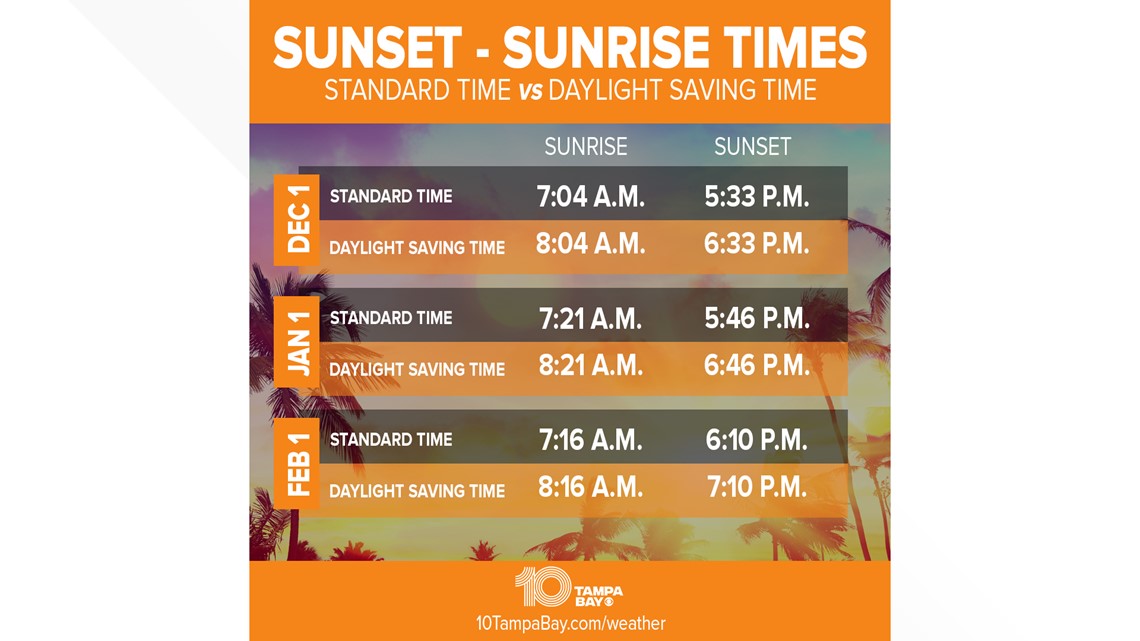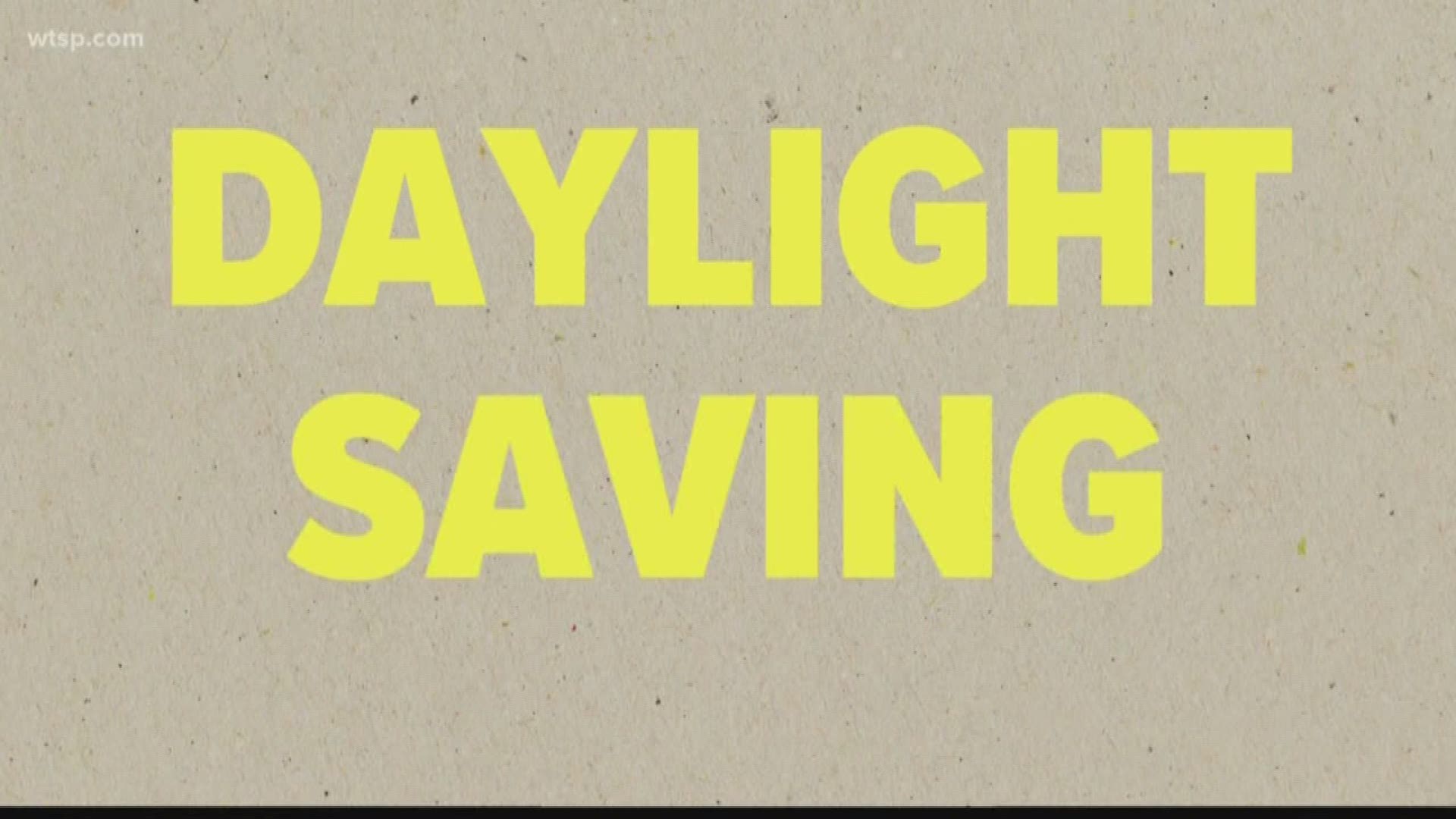This weekend, Americans will "spring forward" and adjust their clocks for daylight saving time (DST).
You might remember that Florida’s legislature voted to keep the state on DST year-round back in March 2018. That would mean that we wouldn’t move the clock back an hour in the fall, keeping later evening sunsets permanently.
However, Congress oversees time and must approve this bill for Florida to make the change. It just hasn’t been a priority in Washington, D.C., so the bill has been sitting on a desk clock-change after clock-change, year-after-year.
For fans of more daylight in the evening, there may be new hope. And not just in Florida, from coast-to-coast.
A new bipartisan bill has been introduced in the Senate to keep DST for all of the country so that come November, Americans don't have to "fall back" and adjust their clocks again. It’s called the "Sunshine Protection Act of 2021" and was reintroduced by U.S. Senators Marco Rubio R-FL, James Lankford. R-OK, Roy Blunt, R-MO, Sheldon Whitehouse, D-RI, Ron Wyden, D-OR, Cindy Hyde-Smith, R-MS, Rick Scott, R-FL, and Ed Markey, D-MA, on Tuesday.
According to CBS News, fifteen other states, including California, Louisiana, Oregon, South Carolina, Tennessee, Utah and Washington, also want to keep DST year-round; and dozens of other states are looking into doing the same.
The "Sunshine Protection Act of 2021" would apply to states participating in DST by negating Standard Time – which is when Americans set their clocks back an hour between November and March, CBS News says.
If the bill became law, people would keep DST year-round and not change their clocks.
It's important to note: The legislation would not change anything for states and territories that don't participate in DST. As CBS explains, those include most of Arizona, Hawaii, American Samoa, Guam, the Northern Mariana Islands, Puerto Rico and the U.S. Virgin Islands.
Right now, Arizona is two hours behind Florida time. After the clocks change this weekend, Arizona (with the exception of the Navajo Nation which does participate in DST) will fall three hours behind Florida time. If the Sunshine Protection Act of 2021 were to become law, the three-hour time difference would become permanent.
A similar occurrence would happen in Hawaii. Hawaii is currently five hours behind Florida. They'll be six hours behind Florida time after the time change this weekend. Again, with the potential proposed law, this would become permanent.
“Americans’ lifestyles are very different than they were when DST began more than a century ago,” Sen. Sheldon Whitehouse (D-RI) wrote in a statement.
Other than sunny drives home from work, Sen. Rubio's office listed the following as benefits of making Daylight Saving Time permanent nationwide:
- Reduces car crashes and car accidents involving pedestrians: better aligning daylight hours to drivers’ standard work hours’ increases visibility, according to the American Journal of Public Health and the Journal of Safety Research. Also reduces the number of vehicle collisions with wildlife by 8 – 11 percent by shifting normal traffic patterns to an hour off from nocturnal wildlife’s behavior.
- Reduces risk for cardiac issues, stroke and seasonal depression.
- Reduces the number of robberies by 27 percent, according to a 2015 Brookings Institution because of additional daylight in the evenings.
- Benefits the economy, according to a study by JP Morgan Chase, which found that there is a drop in economic activity of 2.2 percent – 4.9 percent when clocks move back.
- Reduces childhood obesity and increases physical fitness, according to studies published by the International Journal Behavioral Nutrition and Physical Activity and the Journal of Physical Activity and Health, children see an increase in physical activity during DST. The Journal of Environmental Psychology found that DST increased pedestrian activity by 62% and cyclists activity by 38% because of additional daylight.
- Benefits the agricultural economy, which is disproportionately disrupted by biannual changes in time by upsetting the synergy between farmers’ schedules and their supply chain partners.
- Reduces energy usage, a 2008 study by the U.S. Department of Energy found that during the 4 weeks the U.S. extended daylight savings from the 2005 law, there were savings of about 0.5 percent in electricity per day. Later studies have also shown that the energy savings are minimal but a small savings does occur.
According to WebExhibits.org, DST was first enacted in the U.S. in 1916 as a means of conserving fuel during WWI but wasn't formally adopted until 1918.
"After the War ended, the law proved so unpopular (mostly because people rose earlier and went to bed earlier than people do today) that it was repealed in 1919 with a Congressional override of President Wilson's veto," WebExhibits.org explained.
A handful of states and cities kept it anyway.
President Franklin Roosevelt put year-round "War Time" DST in place during WWII. But, after the war, there weren't federal laws on DST, so local governments chose whether they wanted to observe it – and when.
"This understandably caused confusion, especially for the broadcasting industry, as well as for railways, airlines, and bus companies. Because of the different local customs and laws, radio and TV stations and the transportation companies had to publish new schedules every time a state or town began or ended Daylight Saving Time," WebExhibits.org added.
In 1966, Congress passed the Uniform Time Act which created a National Standard Time and permanently overrode local time changes, the U.S. Department of Defense explains. That decision established Daylight Saving Time to go from the last Sunday in April to the final Sunday in October.
"Portions of the law have been changed a few times since, including to the dates when the 'spring' forward and 'fall' back happen," the Defense Department said. "The current policy was implemented by President George W. Bush in 2005, extending daylight saving time by a few weeks. It now starts on the second Sunday in March and ends on the first Sunday in November. "
Fast forward to 2021. If the "Sunshine Protection Act of 2021" is passed, how would it affect the time of Tampa Bay sunrise and sunset times?
Critics would argue that morning school bus stops and commutes to work would be in the dark. December, January and February sunrises would occur a little after 8 a.m. instead of just after 7 a.m.
The extra daylight is shifted to the evenings. The 5 o’clock sunsets will occur after 6:30 p.m., even during the shortest winter days.


Will the bill actually become a law this time? This bill is in the first stage of the legislative process. It was introduced into Congress on Jan. 4, 2021.
It will typically be considered by a committee next before it is possibly sent on to the House or Senate as a whole.
- Third stimulus check update: House set to pass COVID bill with $1,400 payments today
- Texts show Manatee County leader, developer discuss how vaccine pop-up site could help Gov. DeSantis
- Biden's first 50 days: Where he stands on key promises
- Fallen Tampa officer veered cruiser into path of wrong-way driver to keep others safe, chief says
- Confusion at FEMA vaccine site leads to people who thought they were eligible being turned away
►Breaking news and weather alerts: Get the free 10 Tampa Bay app
►Stay In the Know! Sign up now for the Brightside Blend Newsletter

